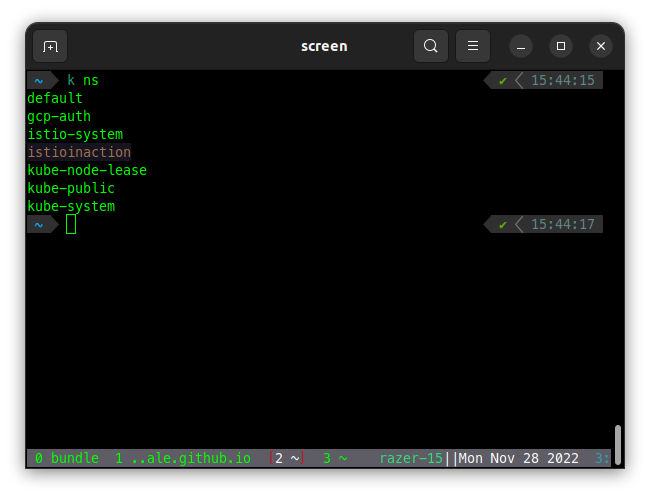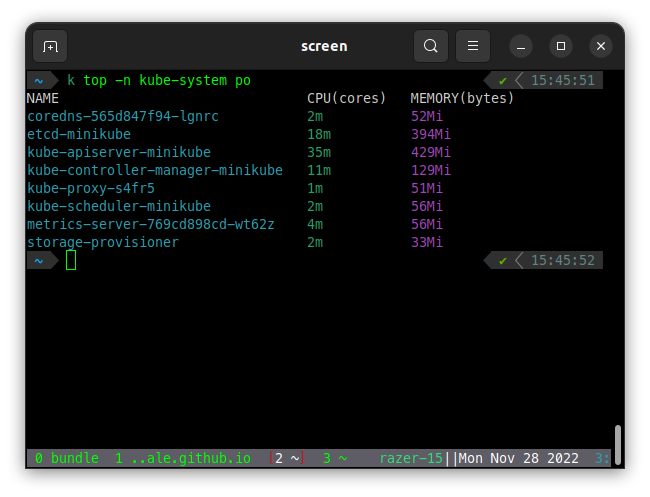kubectl is the official tool to query and run changes on a Kubernetes cluster and provides a powerful and extensible CLI interface. There are many alternative tools out there that do a similar job (some with GUIs); I deliberately stick with kubectl on my road to master Kubernetes, which means I try not to hide too much of the complexity in the hopes of burning them into my mind. Sometimes though, there are actions that are far too elaborate or complicated considering the number of times I need to execute them. Other times, I just wish the tool itself offered some slight quality of life improvements to the overall experience.
Following are the plugins I personally use all the time to scratch some of my itches with daily use of kubectl. Before we go into those, let’s first quickly go over a few productivity hacks:
Productivity Hacks
Aliasing
Considering how many times a day I run a command with kubectl, I estimate aliasing this command probably saves me hundreds of keystrokes per day.
Alias kubectl to a shorter string that is meaningful to you. I use k and honestly it’s probably the convention at this point:
1
2
3
4
5
$ alias k=kubectl
$ k get po
NAME READY STATUS RESTARTS AGE
web-0 1/1 Running 1 (94s ago) 2d15h
...
Shortnames
Familiarize yourself with the short names of the resource definitions recognized by your cluster:
1
2
3
4
# compare this:
$ k get replicationcontrollers
# to this:
$ k get rc
Note that not all resources have shortnames.
You can use the
api-resourcescommand to see the shortnames available for the resource definitions in your cluster:Example
Dry runs
kubectl create and kubectl run have the options --dry-run that I find very useful for quickly sketching the basis for a resource I want to create when I set the output to yaml format:
1
2
3
4
5
6
7
8
9
10
11
12
13
14
15
16
17
18
19
20
21
22
23
24
25
$ k create deploy mydeploy --image=nginx --replicas=3 --dry-run=client -o yaml
apiVersion: apps/v1
kind: Deployment
metadata:
creationTimestamp: null
labels:
app: mydeploy
name: mydeploy
spec:
replicas: 3
selector:
matchLabels:
app: mydeploy
strategy: {}
template:
metadata:
creationTimestamp: null
labels:
app: mydeploy
spec:
containers:
- image: nginx
name: nginx
resources: {}
status: {}
You can pipe that output to a file and make additional tweaks there. Bonus points if instead you patch the output directly with kubectl patch (advanced).
Autocompletion
Enable autocompletion for your shell:
Plugins
krew
Plugins can be “installed” to kubectl simply by placing the binary in your $PATH and adding the kubectl- prefix. It’s as simple as:
1
2
3
4
5
# '~/bin` is in my $PATH
$ printf '#!/bin/bash\n\necho $1' > ~/bin/kubectl-echo
$ chmod +x ~/bin/kubectl-echo
$ k echo 'Hello World!'
Hello World!
If you want to avoid the hassle of placing the executables in the correct path, and/or if you would like a tool that can list plugins from a central repository and automatically install those for you, then Krew is for you.
Krew is a package manager maintained by the Kubernetes Special Interest Group (SIG) CLI and can do all of this for you:
1
2
3
4
5
6
7
8
9
10
11
12
13
14
15
16
17
18
19
20
21
22
23
24
25
26
27
28
29
30
31
32
33
34
35
36
37
38
39
40
41
42
43
# List all plugins in the repo:
$ k krew search
NAME DESCRIPTION INSTALLED
access-matrix Show an RBAC access matrix for server resources no
accurate Manage Accurate, a multi-tenancy controller no
advise-policy Suggests PodSecurityPolicies and OPA Policies f... no
advise-psp Suggests PodSecurityPolicies for cluster. no
...
# Show info for a plugin:
$ k krew info advise-policy
NAME: advise-policy
INDEX: default
URI: https://github.com/sysdiglabs/kube-policy-advisor/releases/download/v1.0.2/kube-policy-advisor_v1.0.2_linux_amd64.tar.gz
SHA256: 2d3968fd80d6fe40976dbc86655ef8fe3e6ea4bcb0c43fafb99a39000daa549f
VERSION: v1.0.2
HOMEPAGE: https://github.com/sysdiglabs/kube-policy-advisor
DESCRIPTION:
Suggests PSPs and OPA Policies based on the required capabilities of the currently running
workloads or a given manifest.
# Install a plugin:
$ k krew install advise-policy
Updated the local copy of plugin index.
Installing plugin: advise-policy
Installed plugin: advise-policy
\
| Use this plugin:
| kubectl advise-policy
| Documentation:
| https://github.com/sysdiglabs/kube-policy-advisor
/
WARNING: You installed plugin "advise-policy" from the krew-index plugin repository.
These plugins are not audited for security by the Krew maintainers.
Run them at your own risk.
# List installed plugins:
$ k krew list
advise-policy
ctx
krew
ns
...
ctx
ctx is a simple plugin to switch between contexts (clusters) with kubectl. This is a great timesaver when you constantly have to switch between different contexts (clusters). You can install it with k krew install ctx.
View configured contexts:
The normal way:
1
2
3
4
5
$ k config get-contexts
CURRENT NAME CLUSTER AUTHINFO NAMESPACE
* myclusterA myclusterA myclusterA default
myclusterB myclusterB myclusterB default
myclusterC myclusterC myclusterC default
Using ctx:
1
2
3
4
$ k ctx
myclusterA
myclusterB
myclusterC
Switch context:
The normal way:
1
2
$ k config set-context myclusterA
Context "myclusterA" modified.
Using ctx:
1
2
$ k ctx myclusterA
Switched to context "myclusterA".
ns
ns is a sibling of ctx with a very similar purpose: it allows you to easily list and change between namespaces. This is another big timesaver. You can install it with k krew install ns.
List namespaces:
The normal way:
1
2
3
4
5
6
7
8
9
$ k get ns
NAME STATUS AGE
default Active 116d
gcp-auth Active 34d
istio-system Active 112d
istioinaction Active 112d
kube-node-lease Active 116d
kube-public Active 116d
kube-system Active 116d
Using ns:
1
2
3
4
5
6
7
8
$ k ns
default
gcp-auth
istio-system
istioinaction
kube-node-lease
kube-public
kube-system
Switching namespaces (this is a big one):
The normal way:
1
2
$ k config set-context --current --namespace=kube-public
Context "myclusterA" modified.
Using ns:
1
2
3
$ k ns kube-public
Context "myclusterA modified.
Active namespace is "kube-public".
tail
tail is a great plugin for streaming logs from pods. It extends the builtin kubectl logs functionality with the ability to figure out the labels of the pods for you when you point it to a Service or a controller. You can install it with k krew install tail.
Example:
1
2
3
4
5
6
7
$ k create deploy mydeploy --image=mysql:latest
deployment.apps/mydeploy created
$ k tail -d mydeploy
kube-public/mydeploy-d8c5f59cc-xjdn2[mysql]: 2022-11-28 20:10:32+00:00 [Note] [Entrypoint]: Entrypoint script for MySQL Server 8.0.31-1.el8 started.
kube-public/mydeploy-d8c5f59cc-xjdn2[mysql]: 2022-11-28 20:10:32+00:00 [Note] [Entrypoint]: Switching to dedicated user 'mysql'
kube-public/mydeploy-d8c5f59cc-xjdn2[mysql]: 2022-11-28 20:10:32+00:00 [Note] [Entrypoint]: Entrypoint script for MySQL Server 8.0.31-1.el8 started.
...
Another awesome feature is that it does not require RUNNING pods - it just keeps listening for any pods with the matching criteria. This is unlike kubectl logs -f which fails if there are no matching RUNNING pods. This is great when you don’t want to waste time waiting for the deployment to be live to finally execute a command that tails the logs.
deprecations
deprecations lists all standard K8S resources found in your cluster that are deprecated (as found in Kubernetes’ OpenAPI spec). This is a handy tool that helps you keep your cluster and resources up-to-date. You can install it with k krew install deprecations.
1
2
3
4
5
6
7
8
9
10
11
12
13
14
$ k deprecations
W1128 15:24:46.214313 450713 warnings.go:70] v1 ComponentStatus is deprecated in v1.19+
RESULTS:
Deprecated APIs:
ComponentStatus found in /v1
├─ ComponentStatus (and ComponentStatusList) holds the cluster validation info. Deprecated: This API is deprecated in v1.19+
-> GLOBAL: scheduler
-> GLOBAL: controller-manager
-> GLOBAL: etcd-0
Deleted APIs:
safe
Do you sometimes feel your spidey sense tingling and your palms sweating a little bit as you constantly switch between contexts (k ctx) and namespaces (k ns) while you query the cluster and modify resources? Have you ever thought that maybe you’re being a bit too cavalier with your k8s-foo and should probably slow down and double-check the command you’re about to run before you hit Enter? safe](https://github.com/rumstead/kubectl-safe) is here to assuage your fears. You can install it with k krew install safe.
1
2
3
4
5
6
7
# Alias to ensure you're always SAFE:
$ alias k=kubectl safe
# Queries work as usual:
$ k get po
# Changes must be acknowledged however:
$ k create deploy mydeploy --image=nginx
You are running a create against context myclusterA, continue? [yY]
kubecolor
kubecolor replaces kubectl and colorizes the output1. Since it’s a replacement binary, you cannot install it with krew - you either download a prebuilt binary or build it yourself.
Examples:


Footnotes
Make sure you install from this fork/branch to fix compatibility issues with
ctxandns. ↩
